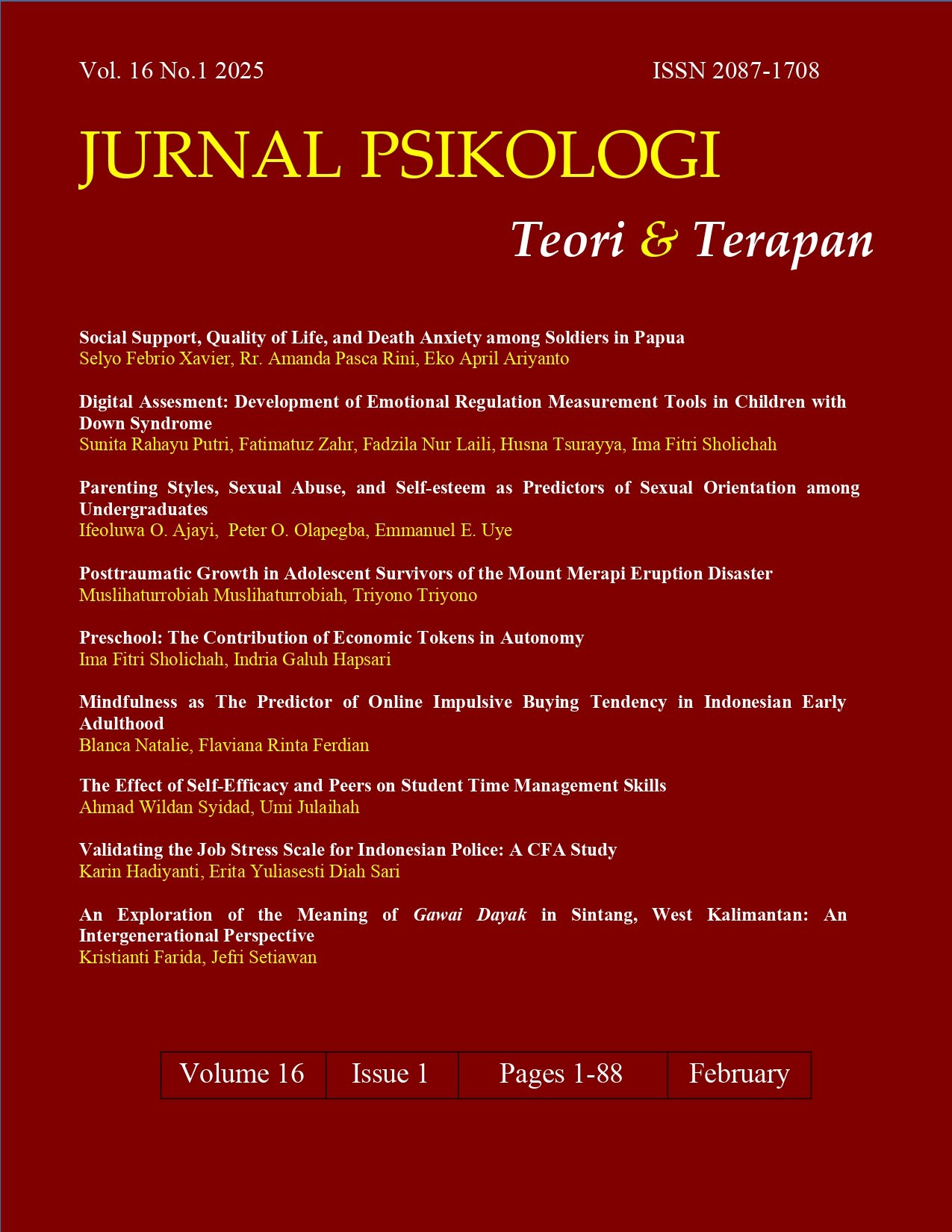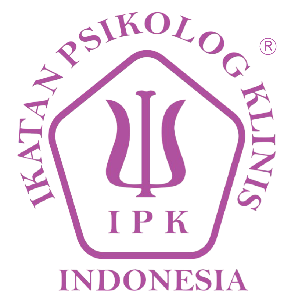The Effect of Self-Efficacy and Peers on Student Time Management Skills
DOI:
https://doi.org/10.26740/jptt.v16n01.p57-68Keywords:
Mahasantri, peers, self-efficacy, time managementAbstract
Background: Students living in the Ma'had environment must face challenges in determining the scale of priorities due to the density of academic, religious and social activities. Therefore, time management skills are needed to overcome this. Objective: This study aims to analyze the influence of self-efficacy and peers on the time management skills of Mahasantri. Method: This study uses a quantitative approach with the Structural Equation Modeling-Partial Least Squares (SEM-PLS) method to analyze data from 278 respondents selected using the simple random sampling technique. Results: The results of the study showed that self-efficacy has a significant and dominant influence on time management skills, while peers have a positive but weaker influence. In addition, self-efficacy also acts as a mediator that strengthens the relationship between peers and time management. Conclusion: This study shows that individuals with high levels of self-efficacy are more able to manage time effectively. The implication of this study is the importance of improving students' self-efficacy through mastery experience programs and group guidance to strengthen social support from peers.
Keywords: Mahasantri; peers; self-efficacy; time management.
Abstrak
Latar Belakang: Mahasantri yang tinggal di lingkungan Ma’had harus menghadapi tantangan dalam menentukan skala prioritas akibat padatnya aktivitas akademik, keagamaan, dan sosial. Oleh karena itu dibutuhkan keterampilan manajemen waktu dalam mengatasi hal tersebut. Tujuan: Penelitian ini bertujuan untuk menganalisis pengaruh self-efficacy dan teman sebaya terhadap keterampilan manajemen waktu Mahasantri. Metode: Penelitian ini menggunakan pendekatan kuantitatif dengan metode Structural Equation Modeling-Partial Least Squares (SEM-PLS) untuk menganalisis data dari 278 responden yang dipilih menggunakan teknik simple random sampling. Hasil: Hasil penelitian menunjukkan bahwa self-efficacy memiliki pengaruh signifikan dan dominan terhadap keterampilan manajemen waktu, sedangkan teman sebaya memberikan pengaruh positif tetapi lebih lemah. Selain itu, self-efficacy juga berperan sebagai mediator yang memperkuat hubungan antara teman sebaya dan manajemen waktu. Simpulan: Studi ini menunjukkan bahwa individu dengan tingkat efikasi diri yang tinggi lebih mampu mengelola waktu secara efektif. Implikasi dari penelitian ini adalah pentingnya meningkatkan efikasi diri siswa melalui program pengalaman penguasaan dan bimbingan kelompok untuk memperkuat dukungan sosial dari teman sebaya.
Kata Kunci: Efikasi diri; mahasantri; manajemen waktu; teman sebaya.
References
Andre, M., Rahmanto, N., & Satyawan, I. A. (2020). Challenges and Opportunities for Mahasantri Da'wah through Social Media. International Journal of Multicultural and Multi Religious Understanding, 7(4), 355-363.
Budiaji, W., Faculty, D., University, P., Tirtayasa, A., Raya, J., Km, J., & Serang Banten, P. (2019). The Measurement Scale and The Number of Responses in Likert Scale. December Journal of Agricultural and Fisheries Sciences, 2(2), 125-131.
Fajar, P., & Aviani, Y. I. (2022). The Relationship of Self-Efficacy with Self-Adjustment: A Literature Study. Tambusai Journal of Education, 6(1), 2186-2194.
Farihah, D., & Puspitarini, I. Y. D. (2022). Analysis of Time Management Skills of Santri Pondok Pesantren Al-Ishlah in Learning Time to Memorize Kitab Fathul Qorib. Proceedings of Wisdom Counseling ..., 405-411.
Gerbino, M. (2020). Self-efficacy. The Wiley Encyclopedia of Personality and Individual Differences, 1994, 387-391.
Himmah, A. F., & Shofiah, N. (2021). The Effect of Self efficacy and Time Management on Academic Stress in Students. Journal of Indonesian Psychological Science (JIPS), 1(01), 31-38.
Jannah, E. U. (2013). The Relationship Between Self-Efficacy and Intelligence. Pesona, Indonesian Journal of Psychology, 2(3), 278-287.
Khairat, H., Ekawarna, & Rosmiati. (2022). The Influence of Peer Environment, Socio-Economic Status of Parents, and Self Efficacy on Interest in Continuing Studies to College Students of Grade XI SMA Negeri 1 Batang Hari. JJMPIS: Journal of Education Management and Social Sciences, 4(1), 472-482.
Kholisa, N. (2022). The Relationship of Time Management with Work Effectiveness of Employees. Journal of Social and Industrial Psychology, 1(1), 58-59.
Koyuncu, N., & Kadilar, C. (2009). Ratio and product estimators in stratified random sampling. Journal of Statistical Planning and Inference, 139(8), 2552-2558.
Linda, O., & Rachmawati Faculty of Public Health Sciences, E. (2020). Peer Group Program in an Effort to Prevent Hiv&Aids in Adolescents at Sma Muhammadiyah 4 Jakarta. BERNAS: Journal of Community Service, 1(2), 116-119.
Mardiatmoko, G.-. (2020). The Importance of the Classical Assumption Test in Multiple Linear Regression Analysis. BAREKENG: Journal of Mathematical and Applied Sciences, 14(3), 333-342.
Mariani, I., Zulkifli, & Mulyani, R. R. (2023). The Influence of Peers' Role on Students' Learning Independence in Class XII IPS SMA Negeri 3 Pariaman Ika. Journal of Education and Counseling, 5(2), 775-780.
Motoh, T. C., & Saharudin. (2020). Time Management of Islamic Boarding Schools on Student Learning Outcomes Case Study of MTS DDI Siapo. Nusantara: Journal of Education Science, 1(2), 40-46.
Muhammad Fadhli, Mansur Hidayat Pasaribu, M. F. R. H. (2020). Education Quality Management: Perspective of Al-Quran and Tafsir. Education Achievement: Journal of Science and Research, 1(1), 1-15.
Nanda, D. M., & Jannah, N. (2020). Comparison of Time Management on College Students. Journal of Nursing, IV (2), 141-148.
Sasmita, I. A. G. H. D., & Rustika, I. M. (2015). The Role of Self-Efficacy and Peer Social Support on Self-Adjustment of First-Year Students of the Medical Education Study Program, Faculty of Medicine, Udayana University. Udayana Journal of Psychology, 2(2), 280-289.
Supriyatno, T. (2006). Model of Internalization of Religious Values in Mahad Sunan Ampel Al-Ali Uin Malang. El-QUDWAH, 0(0).
Ummah, M. S. (2019). Slovin's Formula: Panacea for Sample Size Problems? Sustainability (Switzerland), 11(1), 1-14.
Yulyani, R. D. (2022). The Effect of Learning Motivation, Learning Interest, and Time Management on Student Learning Achievement during Limited Face-to-Face Learning Period. Edumaspul: Journal of Education, 6(1), 943-952.
Adawiyah, D. P. R. (2020). Pengaruh Penggunaan Aplikasi TikTok Terhadap Kepercayaan Diri Remaja di Kabupaten Sampang. Jurnal Komunikasi, 14(2), 135–148.
Aini, S., & Daulai, A. F. (2024). Analisis implementasi program pembinaan kedisiplinan dalam membina akhlak siswa. Jurnal EDUCATIO: Jurnal Pendidikan Indonesia, 10(1), 307.
Alwie, rahayu deny danar dan alvi furwanti, Prasetio, A. B., Andespa, R., Lhokseumawe, P. N., & Pengantar, K. (2020). Tugas Akhir Tugas Akhir Bandeng. Jurnal Ekonomi Volume 18, Nomor 1 Maret201, 2(1), 41–49.
Ayu Nadia Putri. (2021). Hubungan Tingkat Pengetahuan, Keterpaparan Media, Teman Sebaya Dengan Perilaku Seksual Berisiko Pada Remaja Sma Negeri 6 Kota Jambi. Pharmacognosy Magazine, 75(17), 399–405.
Biglan, A. (1987). A Behavior-Analytic Critique of Bandura’s Self-Efficacy Theory. The Behavior Analyst, 10(1), 1–15.
Bima Sakti, A., Wingkolatin, & Marwiah. (2024). Analisis Peran Organisasi Siswa Intra Sekolah (OSIS) Sebagai Pembentuk Karakter Kepemimpinan Siswa di SMA Negeri 2 Tenggarong Seberang. Jurnal Ilmu Pendidikan Dan Psikologi, 1(3), 317–330.
Hadi, S., Sholihah, Q., & Warsiman, W. (2022). Pembelajaran Inovatif Pendidikan Karakter Pada Mata Kuliah Bahasa Indonesia Meningkatkan Kualitas Sikap, Minat, dan Hasil Belajar Siswa. Briliant: Jurnal Riset Dan Konseptual, 7(4), 905.
Juliandi, A. (2018). Structural Equation Model Partial Least Square (SEM-PLS) Menggunakan SmartPLs. Jangan Belajar, 1(was), 1–4.
Kusumawardani, W., Nursalam, N., & Nihayati, H. E. (2020). The Effect of a Combination of Group Therapy and Support on the Self-Efficacy and Deviant Behavior of Adolescents. Jurnal Ners, 15(2 Special Issue), 548–552.
Lumbantoruan, M., Sirait, A., & Sidabukke, I. (2023). Peningkatan Breasfeeding Self Efficacy Melalui Edukasi Teman Sebaya (Peer Education). JOMIS (Journal of Midwifery Science), 7(1), 86–91.
Mangkunegara, A. P., & Prabu, A. (1993). Evaluasi kinerja SDM, Bandung, PT Refika Aditama. Abdul Latief, 2, 772–781.
Megantoro, X. (2015). Hubungan interaksi teman sebaya dengan penyesuaian diri di sekolah pada siswa baru di smkkristen salatiga tahun ajaran 2015/2016. 1–23.
Saputra, W. R., Hendri, M., & Aminoto, T. (2019). Korelasi Motivasi Dan Hasil Belajar Ipa Siswa Kelas Viii Di Smp Negeri Se-Kecamatan Jambi Selatan. EduFisika, 4(01), 36–45. https://doi.org/10.22437/edufisika.v4i01.3996
Sari, P. M. (2023). Kualitas Laporan Keuangan Umkm Berbasis Sak Emkm : Self Efficacy Sebagai Variabel Moderasi. Oikos : Jurnal Ekonomi Dan Pendidikan Ekonomi, 7(1), 164–176.
Yuliza, E., Izzah, L., Kurniawan, W., & Adewila Putri, L. (2022). Pengaruh Manajemen Waktu dan Efikasi Diri Terhadap Prokrastinasi Mahasiswa Pekerja Tingkat Akhir STAI Diniyah Pekanbaru. Al-Mutharahah: Jurnal Penelitian Dan Kajian Sosial Keagamaan, 19(2), 354–370.
Downloads
Published
How to Cite
Issue
Section
License
Copyright (c) 2025 wildan syidad

This work is licensed under a Creative Commons Attribution 4.0 International License.
Authors who publish in this journal agree to the following terms:
Copyright in any article is held by the author.
The author grants the journal, publication rights with the work simultaneously licensed under a Creative Commons Attribution License that allows others to share the work with an acknowledgment of the work's authorship and initial publication in this journal.
Authors may enter into separate, additional contractual arrangements for the non-exclusive distribution of the journal's published version of the work (e.g., posting it to an institutional repository or publishing it in a book), with an acknowledgment of its initial publication in this journal.
Authors are permitted and encouraged to post their work online (e.g., in an institutional repository or on their website) prior to and during the submission process, as this can lead to productive exchanges, as well as earlier and greater citation of published work.
 Abstract views: 837
,
Abstract views: 837
, PDF Downloads: 714
PDF Downloads: 714


















